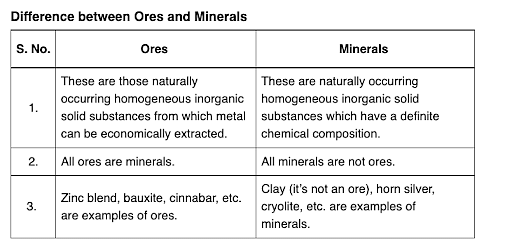The methods NOT involved in concentration of ore are
A Liquation
B Leaching
C Electrolysis
D Hydraulic washing
E Froth floatation
Choose the correct answer from the options given below :
The methods NOT involved in concentration of ore are
A Liquation
B Leaching
C Electrolysis
D Hydraulic washing
E Froth floatation
Choose the correct answer from the options given below :
Show Hint
- B, D and E only
- $C , D$ and $E$ only
- $A$ and $C$ only
- B, D and C only
The Correct Option is C
Approach Solution - 1
(i) Hydraulic Washing
(ii) Froth Flotation
(iii) Magnetic Separation
(iv) Leaching
Approach Solution -2
Methods involved in concentration of ore are:
- (i) Hydraulic Washing
- (ii) Froth Flotation
- (iii) Magnetic Separation
- (iv) Leaching
Thus, Liquation and Electrolysis are NOT typically involved in the concentration of ores. These methods are not commonly used to separate or purify ores. Therefore, the correct answer is A and C only, as they are the most effective methods for concentrating ores.
Top Questions on Concentration of ores
- Which of the following are carbonate ores?
I. Siderite
II. Kaolinite
III. Calamine
IV. Sphalerite- AP EAPCET - 2025
- Chemistry
- Concentration of ores
- Identify the sulphide ore among the following:
- TS POLYCET - 2025
- Chemistry
- Concentration of ores
- Which of the following methods is used for the concentration of ore?
- TS POLYCET - 2025
- Chemistry
- Concentration of ores
- Pyrolusite ore is:
- BCECE Nursing - 2024
- Chemistry
- Concentration of ores
- A → P is a zero-order reaction. At 298 K, the rate constant of the reaction is \( 1 \times 10^{-3} \) mol L\(^{-1}\) s\(^{-1}\). Initial concentration of 'A' is 0.1 mol L\(^{-1}\). What is the concentration of 'A' after 10 sec?
- AP EAMCET - 2024
- Chemistry
- Concentration of ores
Questions Asked in JEE Main exam
A square loop of sides \( a = 1 \, {m} \) is held normally in front of a point charge \( q = 1 \, {C} \). The flux of the electric field through the shaded region is \( \frac{5}{p} \times \frac{1}{\varepsilon_0} \, {Nm}^2/{C} \), where the value of \( p \) is:

- JEE Main - 2025
- Gauss's Law
- Let \( \alpha_1 \) and \( \beta_1 \) be the distinct roots of \( 2x^2 + (\cos\theta)x - 1 = 0, \ \theta \in (0, 2\pi) \). If \( m \) and \( M \) are the minimum and the maximum values of \( \alpha_1 + \beta_1 \), then \( 16(M + m) \) equals:
- JEE Main - 2025
- Binomial Expansion
- Let the foci of a hyperbola be \( (1, 14) \) and \( (1, -12) \). If it passes through the point \( (1, 6) \), then the length of its latus-rectum is:
- JEE Main - 2025
- Hyperbola
- Which of the following is the correct IUPAC name of the given organic compound (X)? The structure of compound $ X $ is as follows: $ \text{H}_3\text{C} - \text{CH}_3 - \text{CH} = \text{CH} - \text{H} - \text{Br} $
- JEE Main - 2025
- Nomenclature Of Organic Compounds
- Suppose A and B are the coefficients of the 30th and 12th terms respectively in the binomial expansion of \( (1 + x)^{2n - 1} \). If \( 2A = 5B \), then \( n \) is equal to:
- JEE Main - 2025
- Coordinate Geometry
Concepts Used:
General Principles and Processes of Isolation of Elements
What are Ores and Minerals?
Minerals are the naturally occurring, homogeneous inorganic solid substances. They are having a definite chemical composition and crystalline structure, hardness and color. For example, copper pyrite, calamine, etc.

Impurities in an ore are called gauge. The removal of a gauge from the ore is called concentration ore.
Several steps are involved in the extraction of pure metal from ores. Major steps are as follows –
- Concentration of the ore
- Isolation of the metal from its concentrated ore
- Purification of the metal